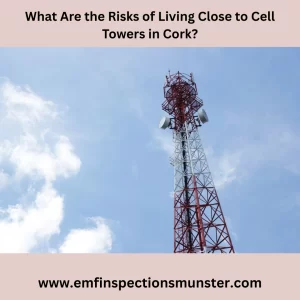Cell towers have become a common sight across urban and rural landscapes in the modern age of constant connectivity. Cork, one of Ireland’s vibrant and fast-developing regions, has also witnessed a surge in installing these towers to support better mobile network coverage. While the benefits of enhanced communication are undeniable, concerns surrounding the potential health impacts of prolonged exposure to cell tower radiation health effects in Cork are increasingly gaining attention. This blog delves deep into the risks of living close to cell towers in Cork and examines the scientific, environmental, and public health perspectives on this issue.
Understanding Cell Tower Radiation
Cell towers emit radiofrequency (RF) electromagnetic fields to communicate with mobile devices. These RF waves are non-ionizing, meaning they do not carry enough energy to break chemical bonds or cause direct DNA damage, unlike ionizing radiation (e.g., X-rays). However, the debate lies in whether chronic exposure to even low levels of RF radiation could potentially impact human health over time.
Proximity and Exposure: How Distance Matters
The intensity of RF radiation significantly drops as you move farther from the source. People living within a 300-meter radius of a cell tower may be exposed to higher levels of radiation compared to those living further away. In Cork’s densely populated neighborhoods, many residential buildings and schools are located close to cell towers, raising valid concerns about long-term exposure effects.
Several international studies have indicated that individuals residing within close proximity to cell towers reported higher instances of symptoms such as:
- Sleep disturbances
- Headaches and migraines
- Fatigue
- Concentration issues
- Tinnitus (ringing in the ears)
Although these symptoms are often subjective and difficult to attribute solely to RF exposure, the pattern is consistent enough to warrant more detailed investigation.
Scientific Evidence and Controversy
The World Health Organization (WHO) classifies RF radiation as a Group 2B possible carcinogen, which places it in the same category as substances like lead and gasoline fumes. While this does not confirm a direct link between cell tower radiation and cancer, it acknowledges the need for more conclusive research.
A notable study conducted in Germany (the Naila Study) observed residents living within 400 meters of a cell tower for over ten years. It found that cancer cases were significantly higher among those living closer to the tower compared to those who lived farther away. Similar patterns were observed in other parts of Europe and Asia, contributing to the growing concern about cell phone tower radiation effects that Cork residents may face.
Children and Vulnerable Populations
Children, pregnant women, and the elderly are considered more vulnerable to environmental hazards, including electromagnetic radiation. Their developing systems and reduced immune responses make them more susceptible to potential health risks.
In Cork, many primary and secondary schools are located near cell towers. This proximity has caused alarm among parents and advocacy groups who demand stricter regulations and buffer zones between cell towers and sensitive areas such as schools and hospitals.
Mental and Cognitive Health Risks
Apart from physical symptoms, RF radiation exposure is also suspected to contribute to neurological and cognitive challenges. Some studies suggest a possible correlation between cell tower proximity and increased levels of stress, anxiety, and reduced memory performance.
Though evidence remains inconclusive, anecdotal reports from Cork residents experiencing brain fog or mood changes have prompted calls for further research and official guidelines.
Environmental Impact
The impact of cell phone tower radiation effects in Cork is not limited to human health. Birds, bees, and other pollinators are reportedly affected by electromagnetic fields. Some studies suggest that RF exposure disrupts navigation systems in birds and impairs reproduction in insects.
Cork, with its rich natural landscapes and biodiversity, could potentially see environmental consequences if these trends hold true. Disruption in local ecosystems could indirectly impact human health through food supply chains and pollination deficits.
Regulatory Measures in Ireland
In Ireland, cell tower installations are regulated by the Commission for Communications Regulation (ComReg) and monitored by the Environmental Protection Agency (EPA). These agencies ensure that emissions from cell towers stay within the limits set by the International Commission on Non-Ionizing Radiation Protection (ICNIRP).
However, critics argue that these limits are based on short-term thermal effects and do not adequately consider the biological effects of long-term exposure to low-level radiation. Communities in Cork have called for more localized assessments and stricter enforcement of precautionary measures.
Community Response and Public Awareness
Over the past few years, several Cork communities have organized petitions and town hall meetings to oppose the installation of new cell towers near residential zones. Parents, educators, and health professionals have voiced their concerns and urged policymakers to adopt the “precautionary principle” until more definitive scientific conclusions can be reached.
Public awareness campaigns are gaining momentum in Cork, educating people on how to minimize exposure, such as:
- Using speaker mode or earphones during phone calls
- Avoid sleeping near mobile phones or Wi-Fi routers
- Advocating for community assessments before new installations
These steps are not only preventive but also help people take control over their immediate environment in the absence of sweeping regulatory changes.
The Role of Technology Alternatives
As concern over radiation exposure grows, alternative technologies are being explored. Small-cell networks and fiber-optic communication can provide faster and more efficient services with reduced emission levels.
Cork’s smart city initiatives could benefit from integrating low-impact technologies while maintaining high connectivity standards. This transition would address both health concerns and infrastructural development needs.
Global Perspective and Local Relevance
While debates around RF radiation are global, the cell phone tower radiation effects that Cork residents experience need a context-specific approach. Geography, population density, existing infrastructure, and public health profiles all contribute to the potential risks.
European cities like Brussels and Florence have adopted stricter guidelines and even halted 5G rollouts until safety is assured. Such precedents could guide Cork and other Irish cities in re-evaluating their policies around cellular infrastructure.
Conclusion:-
The risks of living close to cell towers in Cork reflect a broader global concern that demands urgent and balanced attention. While the technology supporting mobile communication is essential for daily life and economic development, it must be implemented responsibly.
Communities should not have to choose between connectivity and health. Increased research, transparent reporting, and adaptive regulations can help mitigate the risks associated with cell tower radiation.
Moreover, the rise of electrohypersensitivity in Ireland underscores the need to recognize individual sensitivities and offer supportive solutions. As public discourse continues, Cork has the opportunity to lead Ireland in pioneering safer and more inclusive technological development.
Through community engagement, informed policymaking, and ongoing research, Cork can ensure that its journey towards a connected future does not come at the cost of public health and environmental sustainability.
Frequently Asked Questions:-
1. What health symptoms are commonly reported by people living near cell towers?
- Residents living close to cell towers often report symptoms such as sleep disturbances, headaches, fatigue, difficulty concentrating, and tinnitus. While these symptoms are not conclusively linked to RF radiation, the recurring patterns in various studies raise legitimate concerns.
2. Is cell tower radiation classified as dangerous by health organizations?
- The World Health Organization (WHO) classifies radiofrequency (RF) radiation as a Group 2B possible carcinogen, meaning there is limited evidence of carcinogenicity in humans and animals. This highlights the need for more research, particularly regarding long-term exposure.
3. Are there specific concerns for children and schools in Cork?
- Yes, children are more vulnerable to environmental hazards, including RF radiation. Several schools in Cork are located close to cell towers, prompting concern among parents and advocacy groups who are calling for stricter safety regulations and buffer zones around educational institutions.
4. What steps can individuals take to reduce their exposure to cell tower radiation?
- People can reduce exposure by using speaker mode or earphones during calls, keeping mobile devices away from their beds, limiting prolonged device use, and advocating for community assessments before new tower installations in their neighborhoods.
5. How are cell towers regulated in Ireland, and are current standards sufficient?
- In Ireland, cell towers are regulated by ComReg and monitored by the EPA, adhering to ICNIRP guidelines. However, critics argue that these limits focus on short-term thermal effects and may not fully address long-term biological impacts, prompting calls for updated regulations and precautionary measures.


